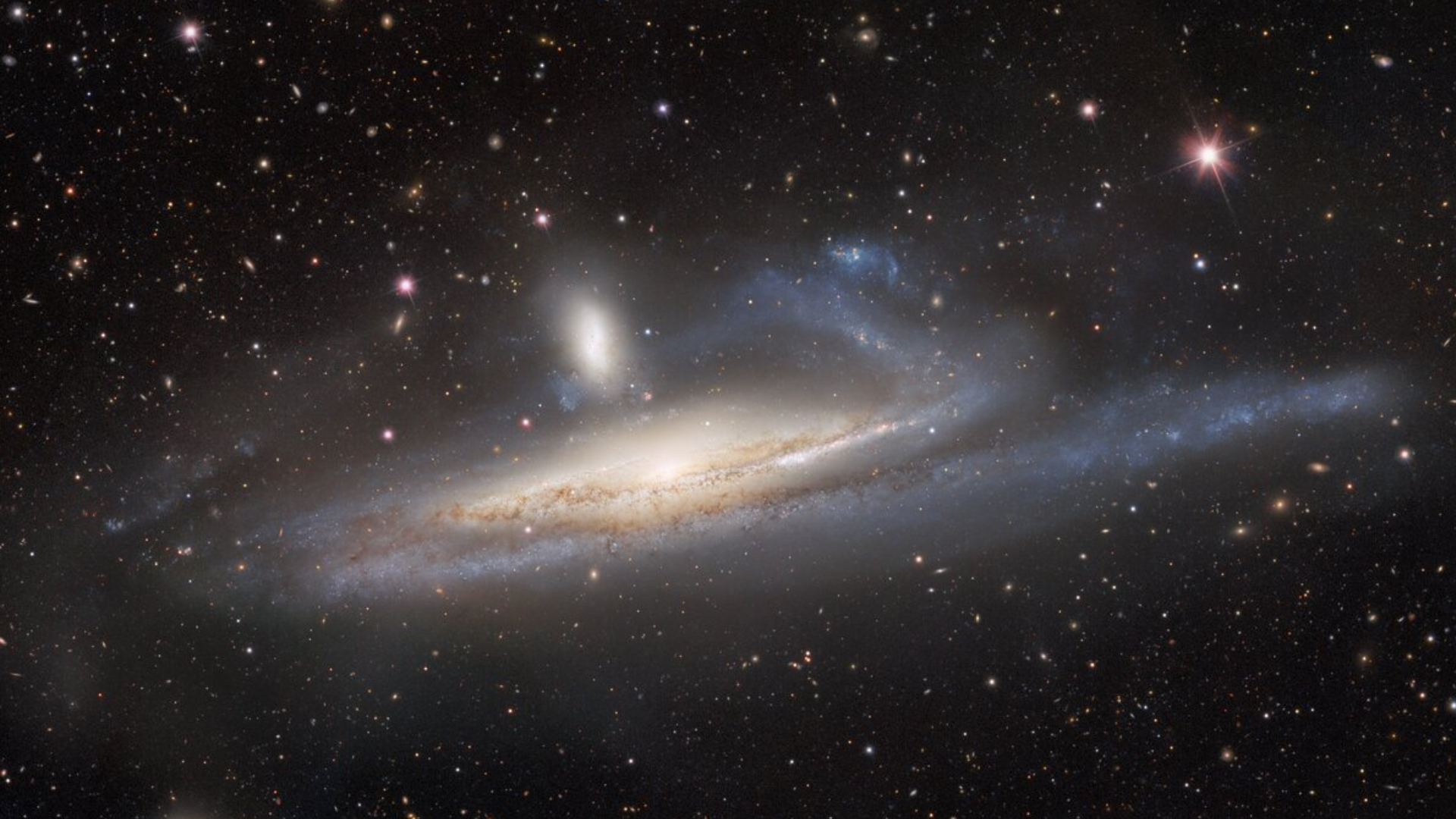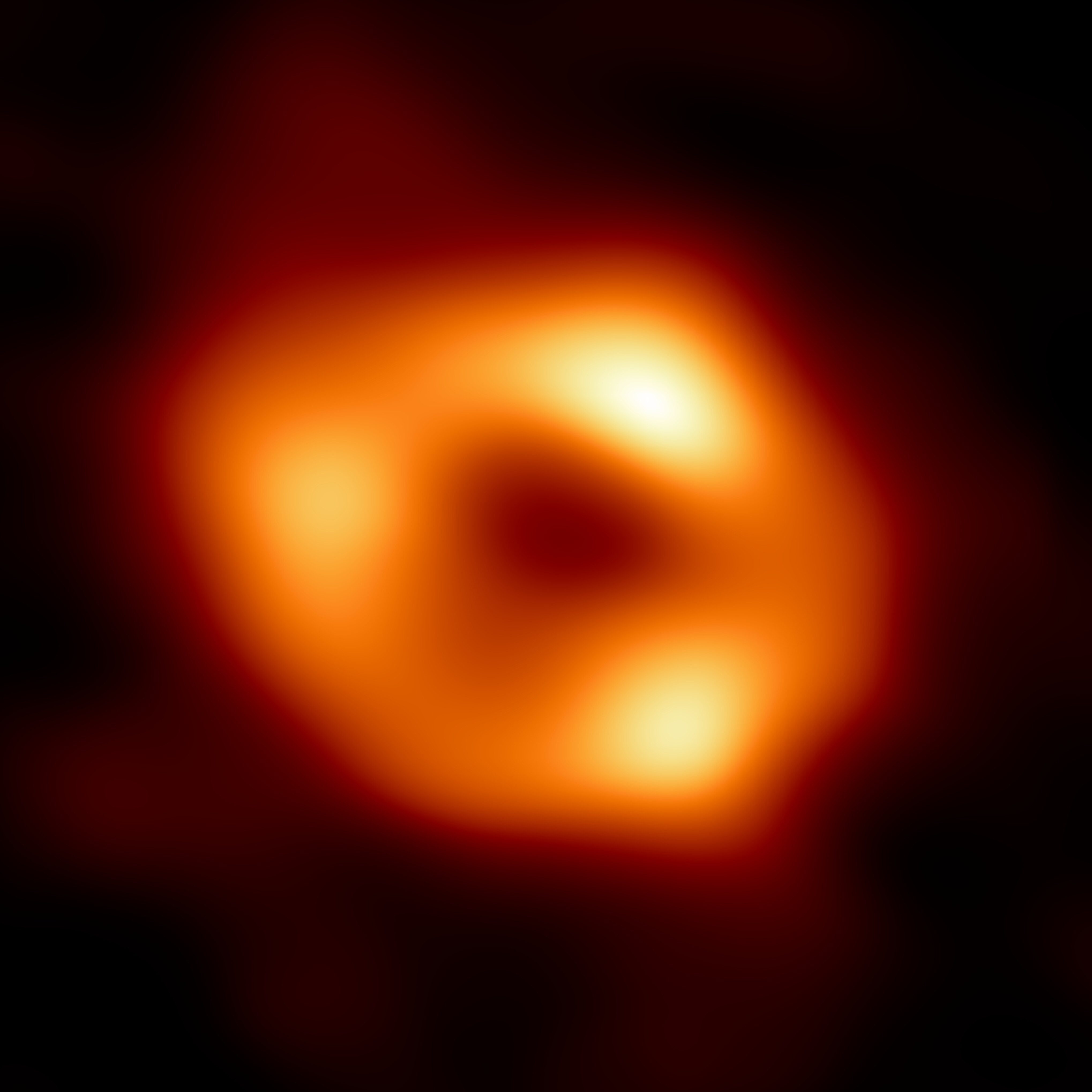Dark energy camera reveals galaxies caught in a cosmic 'tug of war' (photo)
Haley's Coronet is at war with its neighboring dwarf galaxy, and it's a gravitational struggle the latter is bound to lose.

Astronomers have caught a tug of war between a massive galaxy and its smaller dwarf galaxy neighbor.
The smaller galaxy has no chance of prevailing in this deeply one-sided gravitational conflict and will eventually be dragged toward the larger galaxy until they merge. Due to the size difference between the two, this eventual collision is expected to be something like an act of cosmic cannibalism.
The larger galaxy engaged in this cosmic tussle is the massive, barred spiral galaxy NGC 1532, also known as Haley's Coronet. It's located about 55 million light-years away from Earth in the direction of the southern constellation Eridanus, iconic for its striking resemblance to a river. The smaller dwarf galaxy is NGC 1531, which falls around 42 million light-years away from our solar system and is being dragged toward its doom.
Beyond highlighting the very one-sided cosmic struggle between these galaxies, the image, captured by the Dark Energy Camera (DECam) on the Víctor M. Blanco 4-meter Telescope at Cerro Tololo Inter-American Observatory (CTIO), could also reveal how galaxies grow by cannibalizing smaller companions.
Related: James Webb Space Telescope spots the wreckage of a cosmic clash of the Titans (image)
Scientists currently think large galaxies, such as the Milky Way, grow over the course of billions of years by continuously merging with smaller, nearby dwarf galaxies. The new image of Haley's Coronet and NGC 1531 could offer hints as to how the early stages of those merger events play out.
The DECam picture shows an edge-on view of the spiral arms in Haley's Coronet, revealing that the further arm is being wrenched upwards as it pulls on the dwarf galaxy. This distorted radial feature demonstrates that while NGC 1531 is being hopelessly overtaken, it still has a noticeable effect on its larger companion.
Get the Space.com Newsletter
Breaking space news, the latest updates on rocket launches, skywatching events and more!
The image also reveals a bridge made of gas and dust stretching between the two galaxies. It's held in place, scientists say, by tidal forces arising from the gravitational influence of both bodies. Also present, but less obvious in this image, are bouts of star formation within both Haley's Coronet and NGC 1531 triggered by interactions between the realms.
One element of Haley's Coronet appears unconcerned with the ongoing battle with NGC 1531 — the spiral arm closer to Earth looks relaxed as it hangs down from the site of the collision.
The Milky Way is a cosmic cannibal
Throughout the 13.8-billion-year history of the universe, cosmic feeding events such as the one underway between Haley's Coronet and NGC 1531 have been key in supporting the growth of galaxies. In fact, our galaxy is no exception.
While the Milky Way's total body count is somewhat shrouded in mystery, research published in Feb. 2022 posited that it had cannibalized at least six smaller companion dwarf galaxies during its lifetime.
Evidence for this theory is rooted in the star streams scientists observed populating the Milky Way's halo. Oddly enough, those streams seemed to have originated outside our galaxy.
The Milky Way is currently surrounded by at least 59 satellite dwarf galaxies, the largest and most prominent of which are the Large Magellanic Cloud (LMC) and Small Magellanic Cloud (SMC). Both are gravitationally bound to the Milky Way, and many astronomers believe the realms are currently in the process of being digested by our home galaxy.
Astronomers also predict that the LMC, currently 163,000 light years away from the solar system, is set to fully merge with the Milky Way in around 2.4 billion years.
Not only could this trigger a bout of rapid star formation in our galaxy, but also supply the gas and dust necessary to feed the Milky Way's sleeping supermassive black hole, Sagittarius A* (Sgr A*).
This would wake the slumbering titan, which holds a mass equivalent to 4.5 million times that of the sun and currently feeds on a level of material so minuscule it's comparable to a human eating one grain of rice every million years. If woken, the black hole is expected to blast out high-energy radiation.
The mass of Sgr A* could grow by as much as eight times if such "cannibalism" occurs, while the halo of the Milky Way stands to grow in mass by around five times as a result of the event.

The Milky Way is also set for an even more dramatic — and very different — merger in the far future. In around 4 billion to 6 billion years, it's expected to collide with its large neighboring galaxy, Andromeda. This would see both galaxies stripped of their distinctive spiral arms and will eventually cause their central supermassive black holes to merge.
Observing events like the tug of war between Haley’s Coronet and NGC 1531 can therefore hint at some of the interactions in store for the Milky Way when that major collision happens, but astronomers need to search for larger and more chaotic examples to paint a full picture of such an event.
Join our Space Forums to keep talking space on the latest missions, night sky and more! And if you have a news tip, correction or comment, let us know at: community@space.com.

Robert Lea is a science journalist in the U.K. whose articles have been published in Physics World, New Scientist, Astronomy Magazine, All About Space, Newsweek and ZME Science. He also writes about science communication for Elsevier and the European Journal of Physics. Rob holds a bachelor of science degree in physics and astronomy from the U.K.’s Open University. Follow him on Twitter @sciencef1rst.








